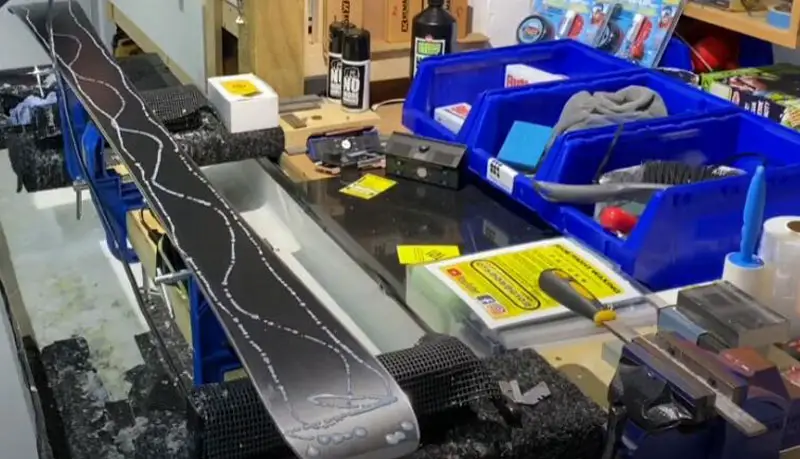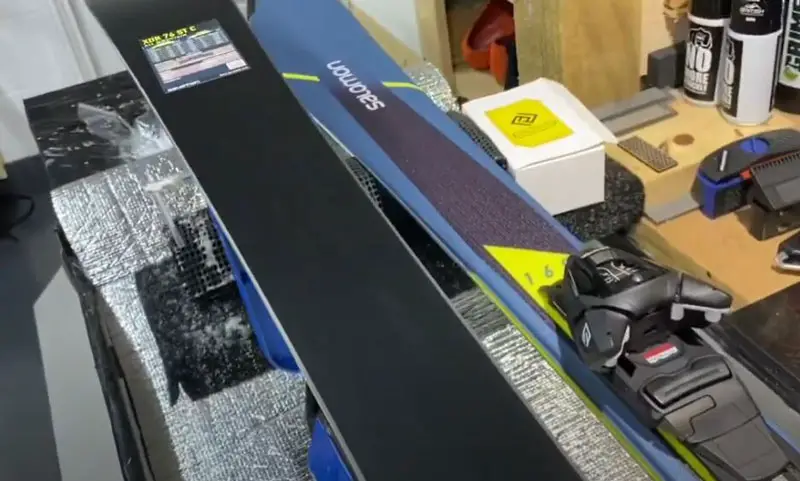Anyone who owns a pair of skis would agree that waxing them is the best way to protect them from scratches and prolong their longevity.
However, most don’t know how often to wax skis, which is why we have written this guide explaining everything you need to know about the matter. So, without any further delay, let’s jump straight to the good stuff.
What Is Ski Tuning?
Ski tuning is a crucial step when it comes to maintaining your ski equipment so that it performs efficiently for years. It mainly involves three steps:
- Base repair
- Edgework
- Waxing
To confirm whether or not your skis need tuning, look at the bases for scratches and scrapes. While smaller gouges and scrapes can be fixed at home, you’ll need a professional to fix bigger ones, especially those at the core.
Next, check the edges for small burrs and rust. If the condition isn’t that bad, do the edge work yourself; otherwise, take it to a ski shop for extensive repairs. Lastly, finish up the tuning by waxing the skis.
We strongly recommend waxing the skis throughout the ski season, even if you are not doing the edge or base repairs to keep them performing at their peak.
Author’s note: Regardless of season or workload, consistency is a priority.
Why Wax Your Skis?

There are two main reasons why you need to wax your skis:
May Prevent Bases from Drying Out
Even though waxing will not save your skis from gouges and scratches caused by rocks and other abrasive materials, it’ll work as a sealant and protect the bases from drying out. Think of it as applying a moisturizer to the skin. Ski bases that are dried out are susceptible to delaminating.
Offers An Effortless Gliding Experience
Waxing the ski will allow an effortless gliding experience because wax acts as a lubricant on the base of the equipment, allowing it to slide easily across the snow surface.
There are numerous types of waxes available on the market and many different ways to apply them. For instance, cross-country skiers use grip wax, whereas Alpine skiers use glide wax, which is melted with a hot iron and then applied. Long story short, each wax has its lifespan and is tailored for a certain condition.
What Happens If You Never Wax Your Skis?
Many people only talk about waxing their skis but never go through the hassle of actually doing the job. So, let us explain what happens if you never do it.
To begin with, you will not be able to glide as smoothly, and the base of your skis will be exposed to friction against rocks and other abrasive surfaces. Needless to say, you put the skis at risk of getting damaged from base burns and snow conditions if you choose not to wax them.
Therefore, we strongly suggest waxing your skis to avoid these issues.
How Often to Wax Skis or Snowboard?

First, you need to make sure that you always dry the skis after using them to avoid corrosion and rust. This becomes all the more important when you store them on a car rack. Ideally, you should wax your skis every 4 to 6 days. If you consider waxing at home, ensure that you iron in about four bars or a kilo of wax per season.
As far as the edgework is concerned, you have to maintain the edges of the skis every day you ride them using a diamond file. However, the actual sharpening should be the same frequency as the waxing, so keep that in mind.
A base grind is highly recommended on newly purchased skis after 5-8 days to allow the epoxy to settle. The process involves removing a small layer of the base of the ski. As such, it can be done only up to 6 times during the lifespan of the ski.
Now, how frequently you grind the base depends on the condition of the ski. For instance, how smooth is it, and how severe are the damages? Note that it is more of an “as needed” basis step, so use your best judgment.
No matter how infrequently you flatten out the base of your skis, it’s crucial for accurate edge engagement. If the ski base is convex, you’ll have difficulty engaging with it; on the other hand, if it’s concave, you’ll catch the edges every time.
You might be interested: Do New Skis Need to Be Waxed?
How Do You Tell If Your Skis Need Waxing?
There are various ways to tell if your skis need waxing. First and foremost, if you see the ski bases getting discolored, then it is probably time you considered waxing them. A white and dusty-looking base also means it’s time to wax.
Apart from that, if you find the entire length of the base to be chalky and off-colored, you need to consider base grinding. You can choose to do it at your home or take it to the nearby ski and let the professionals handle it.
Beyond that, one of the best and most effective ways of knowing if your skis need waxing is to go skiing. If the glides aren’t as smooth as they used to be, it’s certainly about time you got them waxed.
That being said, it’s essential to keep in mind that snow conditions could also affect the gliding speed. But still, you’ll be able to tell if the snow is causing the issue or the ski itself.
Basic Tool List for Ski Maintenance and Repair
| Tool | Purpose |
|---|---|
| Abundant light | – you can’t tune what you can’t see. |
| Workbench | – 35″ to 45″ height is best for most tuning needs. |
| Brake retainers | – keeps ski brakes out of the way when tuning. |
| Vise | – holds skis or snowboard securely for precision work. |
| True bar | – to check bases for flatness. |
| Base flattener | – to flatten the base on your skis or snowboard. |
| P-tex repair material | – to fill base gouges with Repair Pistol or Iron. |
| Surform and Steel Scraper | – to remove excess p-tex after filling. |
| Structure tool | – to impart or refresh the structure in your base. |
| Diamond or Aluminum Oxide stone | – to remove burrs and nicks from your steel edges. |
| Edge bevel tool or guide | – to assure precise base and side edge bevel angles when filing, deburring or polishing |
| File | – to bevel and sharpen steel edges. |
| File brush | – to keep file teeth clean and sharp. |
| Ceramic or Arkansas stone | – to polish edges after filing, and for quick daily edge touch-ups. |
| Brass or steel brush | – to clean out old wax & open base structure. |
| Scotchbrite and Omni-Prep Pad | – to scour away p-tex hairs or fuzz on your base. |
| Wax iron | – to hot wax your ski or snowboard bases. |
| Wax | – to keep your boards sliding and protect the bases. |
| Plastic scraper | – to scrape off excess wax after hot waxing. |
| Wax Brushes | – to remove wax from base structure after waxing. |
| Fiberlene or base tex paper | – to clean bases. |
| Ski Straps | – to protect freshly waxed bases during transport and storage. |
Resource: Tognar
Conclusion
The frequency of waxing depends on a slew of things, but regular skiers should get their skis waxed every 4 to 6 days. This will not only make the skiing experience much better, but it will also enhance the longevity of the equipment.
Furthermore, the base grind is essential, but it doesn’t have to be the same cadence as waxing, as there’s a limit to the number of times you can do it. On that note, we have reached the end of the guide.
Do let us know in the comment section if you have any queries. Until then, take care!


